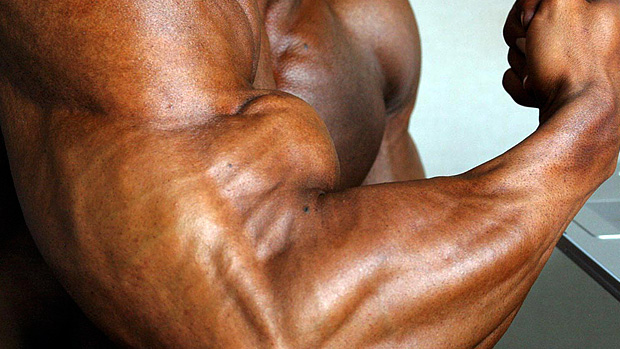Here's what you need to know...
- The muscle snatch is a variation of the snatch movement that's an equalizer for strong guys as it rewards strength over technique.
- It's done much the same way as a snatch, but at exactly the point at which an Olympic lifter would begin moving under the bar, you literally muscle the bar overhead in a pressing movement.
- Aside from being a strength and power hybrid, the muscle snatch is also a technique fixer and an excellent beginner movement for those interested in Olympic lifting.
You may have a problem with Olympic lifts, and I think I know what it is. It's not that you don't like them, but you're tired of seeing normal-sized guys that can't squat or press your warm-up weights using snatch poundages that are fairly mind-blowing.
I have a solution for you. It's called the muscle snatch.
The muscle snatch is an equalizer for the strong guy: it rewards strength over technique. If you can pick up a bar and rip on it, you can do the muscle snatch. No weekend seminars needed, no coaches like me necessary. Just grip it and rip it.
What is the Muscle Snatch?
The muscle snatch is a variation of the snatch movement. The overarching goals of each movement are nearly identical – move the weight from the starting position (floor, hang, or blocks) to overhead in one "continuous" movement.
Like the traditional snatch, the muscle snatch contains a first pull (initiation of the movement from the floor or low-hang position) and a second pull (the rapid acceleration of the bar at the mid-thigh position). But unlike the snatch, the muscle snatch contains no third pull or movement under the bar.
At exactly the point at which an Olympic lifter would begin moving under the bar, you literally muscle the bar overhead in a slightly shortened pressing movement.
How Do You Do It?
Setting up for the muscle snatch is very similar to the normal snatch or clean movement. The only difference might be in the width of your stance. Since there'll be no re-setting of the feet later in the movement, you'll need to assume a stance from which you'll be comfortable doing overhead pressing.
Make sure to keep the bar close when it passes the knees and make sure you feel it contact your thighs the entire way through the second pull. Take full advantage of the momentum your hips create, and then get ready to press the bar out at the top.
The bar should continue its path upward at all points. This means no re-bend of the knees or hips to receive the bar and no stopping during the press to finish the lift. The elbows never descend in the muscle snatch before pressing.
Athletes can use either a clean (close) or snatch (wide) grip to do the movement. Choice of grip is of course dependent upon whether you're seeking improvement in the clean or the snatch movement. In either case, the movement should stop above the head.
Here's a video of me banging out 3 reps at 176 pounds in the muscle snatch:
I'm definitely more of a technique guy than a strength guy, so my muscle snatch isn't that impressive, but you get the idea.
Why is it Worth Your Time?
Your training is already overloaded with the next, newest, and coolest movements, so why should you make time for the muscle snatch?
- It's the perfect strength and power hybrid movement. You're going to be required to move the bar quickly from the start position to overhead in one movement, meaning you'll be developing some serious type II muscle fibers. When the speed of the bar dies though, it's all about strength and only strong athletes can power through the press at the top.
- It's an excellent beginner movement. If you're not an experienced Olympic lifter, the snatch can get pretty frustrating. Small mistakes get magnified over the long distance of the pull and missed lifts can happen frequently. The muscle snatch allows for more error as long as you can power through the top.
- It's a technique fixer. A major flaw for most people working with the full snatch or power snatch is an incomplete hip extension at the top of the second pull. In an effort to move back under the bar, some folks leave the bar short at the top. The muscle snatch fixes that problem just by the nature of the movement. You can feel the bar moving up your thighs and it just keeps going up when you hit the pocket position.
Using the Muscle Snatch
You can add the muscle snatch into your regular program if you want to start trying out the Olympic movements, or you can just do it solely because you want to include some explosive lifting in your training. It can also be used as a technique fix when the regular snatch just isn't going well.
Below is a muscle snatch (Olympic lift intro) program you can use to build some real strength and power. If you don't want to use the program, you can nevertheless take note of the muscle snatch set/rep schemes and merely incorporate them into your regular program.
Week 1, Day 1
| Exercise | Sets | Reps | |
| A | Muscle Snatch (Heaviest weight you can do for all 3 sets.) | 3 | 5 |
| B | Back Squat (80% of 1RM.) | 3 | 5 |
| C | Overhead Press (Done at same weight as muscle snatch.) | 3 | 6 |
Week 1, Day 2
| Exercise | Sets | Reps | |
| A | Muscle Snatch + Overhead Squat | 3 | 3+3 |
| Perform a muscle snatch then, without dropping the bar, perform an overhead squat once you're in the lockout position. That's one rep. | |||
| B | Snatch Grip Deadlift (100% of current 1 rep snatch max.) | 3 | 4 |
| C | Bent over Barbell Row | 3 | 6-8 |
Week 1, Day 3
| Exercise | Sets | Reps | |
| A | Power Clean + Front Squat | 3 | 3+3 |
| Perform a power clean, then without dropping the bar, perform a front squat. That's one rep. | |||
| B | Back Squat (80% of 1RM.) | 3 | 6 |
| C | Push Press (Straight sets.) | 3 | 5 |
Week 2, Day 1
| Exercise | Sets | Reps | |
| A | Muscle Snatch (Heavier than last week.) | 3 | 5 |
| B | Back Squat (85% of 1RM.) | 4 | 4 |
| C | Overhead Press (Done at same weight as muscle snatch.) | 3 | 6 |
Week 2, Day 2
| Exercise | Sets | Reps | |
| A | Muscle Snatch + Overhead Squat | 4 | 2+2 |
| Perform a muscle snatch then, without dropping the bar, perform an overhead squat once you're in the lockout position. That's one rep. | |||
| B | Snatch Grip Deadlift (105% of current 1 rep snatch max.) | 4 | 4 |
| C | Bent over Barbell Row | 3 | 6-8 |
Week 2, Day 3
| Exercise | Sets | Reps | |
| A | Power Clean + Front Squat | 4 | 2+2 |
| Perform a power clean, then without dropping the bar, perform a front squat. That's one rep. | |||
| B | Back Squat (85% of 1RM.) | 3 | 5 |
| C | Neutral Grip Push Press (Straight sets.) | 3 | 5 |
Week 3, Day 1
| Exercise | Sets | Reps | |
| A | Muscle Snatch + Overhead Squat | 4 | 2+2 |
| Heavier than last week. Perform a muscle snatch then, without dropping the bar, perform an overhead squat once you're in the lockout position. That's one rep. | |||
| B | Back Squat (90% of 1RM.) | 4 | 3 |
| C | Overhead Press (Done at same weight as muscle snatch.) | 3 | 5 |
Week 3, Day 2
| Exercise | Sets | Reps | |
| A | Power Clean + Front Squat | 4 | 2+2 |
| Perform a power clean, then without dropping the bar, perform a front squat. That's one rep. | |||
| B | Snatch Grip Deadlift (110% of current 1 rep snatch max.) | 4 | 4 |
| C | Bent over Barbell Row | 3 | 6-8 |
Week 3, Day 3
| Exercise | Sets | Reps | |
| A | Muscle Snatch (Work up to 3RM.) | 3RM | |
| B | Back Squat (90% of 1RM.) | 3 | 4 |
| C | Push Press (Straight sets.) | 3 | 5 |
The muscle snatch will develop total body power and strength for even the most experienced lifters. That's why it's a staple in my programs for both beginners and advanced athletes.




